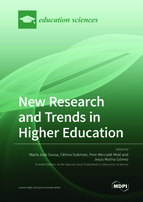New Research and Trends in Higher Education
A special issue of Education Sciences (ISSN 2227-7102). This special issue belongs to the section "Higher Education".
Deadline for manuscript submissions: closed (31 May 2021) | Viewed by 121279
Special Issue Editors
Interests: higher education; digital learning; pedagogies; digital learning technologies
Special Issues, Collections and Topics in MDPI journals
Interests: employability skills of graduates; job quality of graduates; skill problems and employer engagement with higher education
Interests: education in corporate responsibility and sustainability; business ethics
Special Issues, Collections and Topics in MDPI journals
Special Issue Information
Dear Colleagues,
There is growing interest in the field of Higher Education regarding new methodologies, contexts and technologies. In this sense, this Special Issue aims to discuss new research and trends on all dimensions of Higher Education.
It will provide a global forum for the investigation and reporting of diverse issues that affect the learning processes in Higher Education: innovations in learning and new pedagogical methods, and new learning contexts.
Original research contributions are solicited, and authors are invited to contribute with research papers, case studies and demonstrations that present original scientific results, methodological aspects, concepts and educational technologies, on the following topics:
Technological Developments in Higher Education: mobile technology, virtual environments, augmented reality, automation and robotics, and other tools for universal learning, focusing on issues that are not addressed by existing research.
Digital Higher Education: mobile learning, eLearning, Game-based Learning, social media in education, new learning models and technologies and wearable technologies for education.
Case Studies in Higher Education: empirical studies in higher education regarding digital technologies, new methodologies, new evaluation techniques and tools, perceptions of learning processes efficiency and digital learning best practices.
References
Fullan, M. Stratosphere: Integrating technology, pedagogy, and change knowledge. Don Mills, Canada: Pearson. (2013)
Warren, S. J., Dondlinger, M. J., and Barab, S. A. A MUVE towards PBL writing: Effects of a digital learning environment designed to improve elementary student writing. Journal of Research on Technology in Education, 41(1), 113-140. (2008)
Kozma, R. B. Technology and classroom practices: An international study. Journal of Research on Technology in Education, 36(1), 1–14. (2003)
Cheon, J., Lee, S., Crooks, S. M., & Song, J. An investigation of mobile learning readiness in higher education based on the theory of planned behavior. Computers & Education, 59(3), 1054–1064. (2012)
Bocconi, S., Kampylis, P., & Punie, Y. Framing ICT-enabled Innovation for Learning: The case of one-to-one learning initiatives in Europe. European Journal of Education, 48, 113–130. (2013)
Hoskins, B., & Crick, R. D. Competences for learning to learn and active citizenship: Different currencies or two sides of the same coin? European Journal of Education, 45(1), 121–137. (2010)
Dr. Maria José Sousa
Dr. Fátima Suleman
Dr. Pere Mercadé Melé
Dr. Jesús Molina Gómez
Guest Editors
Manuscript Submission Information
Manuscripts should be submitted online at www.mdpi.com by registering and logging in to this website. Once you are registered, click here to go to the submission form. Manuscripts can be submitted until the deadline. All submissions that pass pre-check are peer-reviewed. Accepted papers will be published continuously in the journal (as soon as accepted) and will be listed together on the special issue website. Research articles, review articles as well as short communications are invited. For planned papers, a title and short abstract (about 100 words) can be sent to the Editorial Office for announcement on this website.
Submitted manuscripts should not have been published previously, nor be under consideration for publication elsewhere (except conference proceedings papers). All manuscripts are thoroughly refereed through a double-blind peer-review process. A guide for authors and other relevant information for submission of manuscripts is available on the Instructions for Authors page. Education Sciences is an international peer-reviewed open access monthly journal published by MDPI.
Please visit the Instructions for Authors page before submitting a manuscript. The Article Processing Charge (APC) for publication in this open access journal is 1800 CHF (Swiss Francs). Submitted papers should be well formatted and use good English. Authors may use MDPI's English editing service prior to publication or during author revisions.
Keywords
- Digital Higher Education
- Technological Developments
- Innovations in learning
- New pedagogical methods
- Learning contexts








